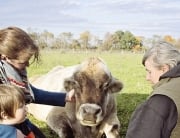
Legitimate animal sanctuaries are essential to providing neglected and abused animals with the lifelong care they need, so here are seven things to consider to ensure that you’re supporting only reputable sanctuaries committed to helping animals:
1. Animals’ Origin
True sanctuaries take in animals rescued from dangerous and exploitative situations. Some of these organizations focus on animals saved from particular places, such as factory farms or roadside zoos, and others may host a variety of animals rescued from many different abusive places. Rescue work is an essential component of how animals arrive at sanctuaries. Many roadside zoos and other shady operations that exploit animals for money purposely deceive and lure in visitors by calling themselves “sanctuaries” or “rescues” and must be avoided. Sometimes true sanctuaries pay for the release of abused animals to their facility, but if a business claiming to be one of them has an agreement to obtain animals from breeders, trappers, or other abusive animal handlers, it’s a scam. Before you enter, ask the facility’s staff to share the rescue stories of some of the animals there, and if they refuse, leave.
2. Breeding
Breeding completely undermines the mission of true sanctuaries, as it treats animals like commodities, contributes to the exotic-animal trade, and fuels the homeless-animal crisis affecting tens of millions of companion animals in the U.S. Every companion animal bred into existence takes away a chance at a loving home from a lonely animal waiting for one in an animal shelter. There’s no legitimate reason for any organization to breed or support breeding animals. Organizations that do so aren’t sanctuaries.
3. Housing
One way to determine whether an organization is a legitimate animal sanctuary is to look at how the animals are housed. It’s essential that animals live in conditions as similar as possible to those they’d enjoy in nature. For example, cows need ample grass to graze on, and ducks need sufficient water to swim in. Big cats, bears, and primates all need a naturalistic environment to explore, roam, climb, and forage in. If it appears the animals at a facility don’t have the opportunity to do the things that come naturally to them, then it’s not a sanctuary. Seeing animals crowded together or fighting with one another is a clear sign that they’re in a stressful and unhealthy place. And although wild animals at reputable sanctuaries are confined in some way, they have adequate space that replicates their natural habitat as closely as possible. If you see animals being held in cramped, barren, or concrete-floored cages, it’s obviously not a true rescue or sanctuary.

Sanctuaries must provide an enriching environment for all the animals they care for. This includes socialization with other animals, access to clean water and ample food, appropriate interaction with sanctuary staff, and ways to play and enjoy themselves. Animals who are social species should also be housed together so they can experience companionship, playtime, and emotional fulfillment. Reputable sanctuaries know the specialized needs of each species they care for and create enriching living conditions for all of them. And providing an enriching environment should always be for the animals’ benefit rather than to impress paying visitors.
5. Facility Size
All animals need enough space to move freely and comfortably and to be alone if they desire. If you notice that animals housed at a facility are crowded together, agitated, or displaying repetitive behavior such as walking in circles, they likely don’t have enough room to live comfortably. A true sanctuary has areas for the animals to run and play and doesn’t confine them to barren or severely crowded enclosures.
6. No-Touch Policy
Legitimate sanctuaries enforce strict policies to prevent visitors from interacting directly with the animals . The public should never be allowed to touch any animals at a facility, as this can be distressing for them and dangerous for them and for visitors. Reputable sanctuaries also don’t allow visitors to pose for pictures with animals because it can be disruptive and frightening to them. A sanctuary should be a comfortable home for its residents, and they, like humans, aren’t comfortable with strangers coming into their home, staring at them, touching them, and making them pose for pictures!
7. Accreditation
The Global Federation of Animal Sanctuaries grants accreditation to sanctuaries that adhere to its strict animal welfare policies. Check out its list of member sanctuaries to be certain you are supporting a reputable facility.
It’s essential that this summer and all year long, we only support true sanctuaries that are committed to the care and rehabilitation of animals and speak up when we see any signs of abuse. PETA recently uncovered rampant animal abuse at Isaiah 11 Ministry in Warsaw, Indiana, a cruel, exploitative organization disguised as a “refuge.” The tireless work of our investigations team led to the facility’s closure, and all its captive animals have been rehomed . Unfortunately, seedy organizations that exploit animals aren’t rare, but we won’t rest until they’re all closed like the Tri-State Zoological Park, the site of the largest roadside zoo rescue in PETA’s history, during which, after a lengthy investigation, 72 animals were given good homes in October 2022.
If you see any indications of animal abuse at any type of facility, be sure to file a report. Animal sanctuaries are vital to giving abused animals the respect and care they deserve, and with these simple steps, you can be assured that you’re supporting facilities that truly are working to make the world a more compassionate place for animals.






